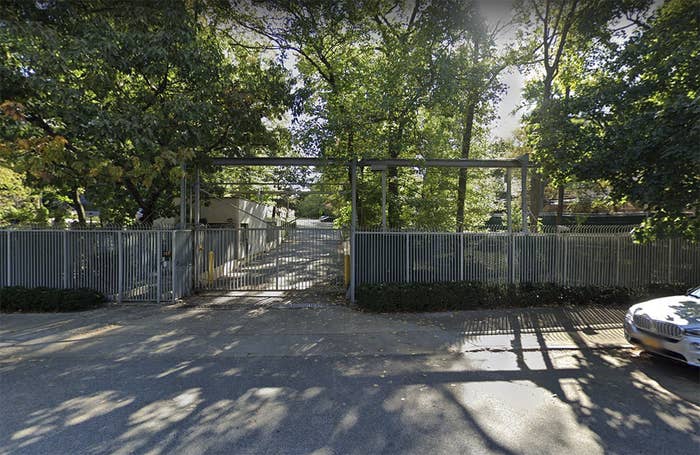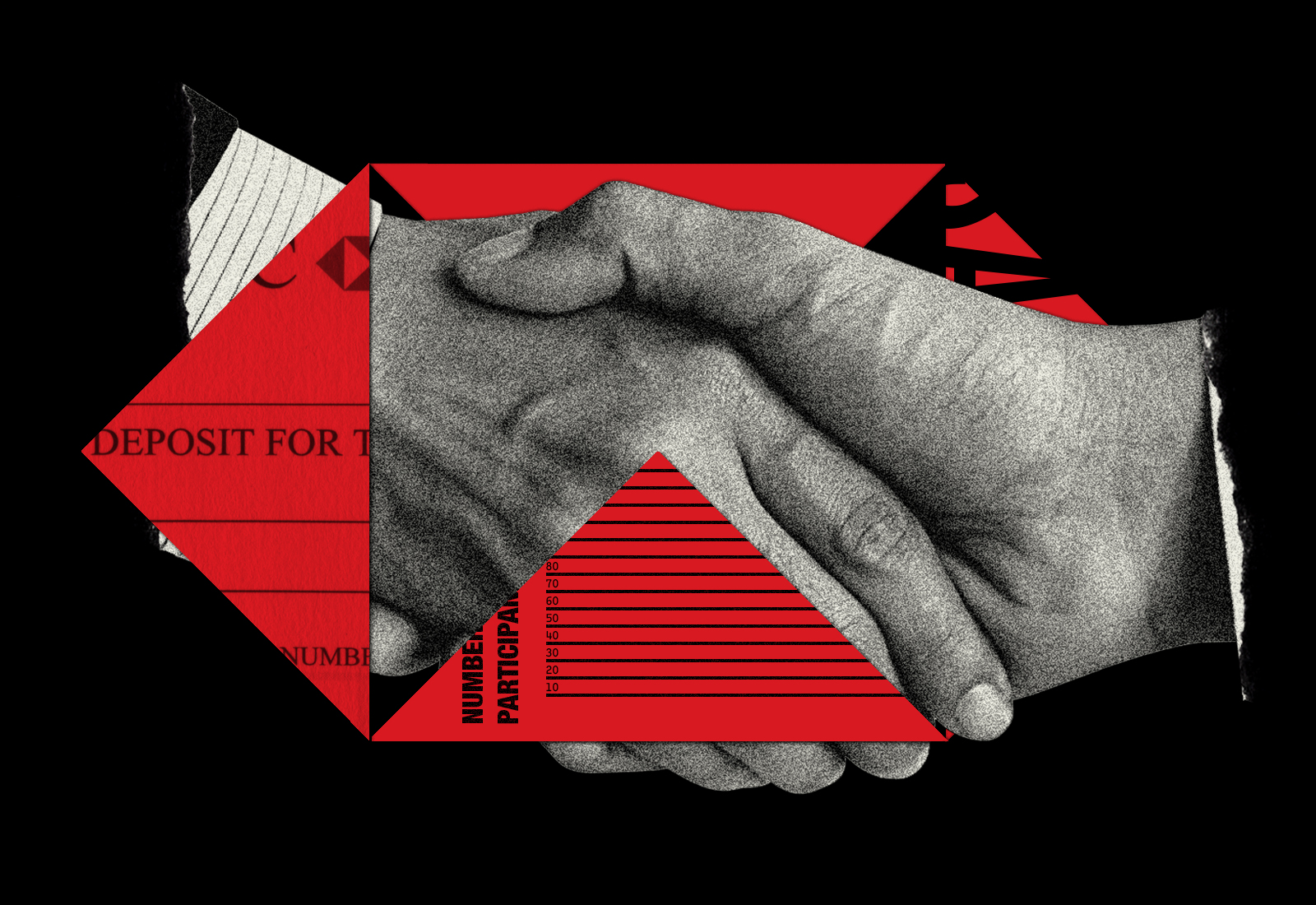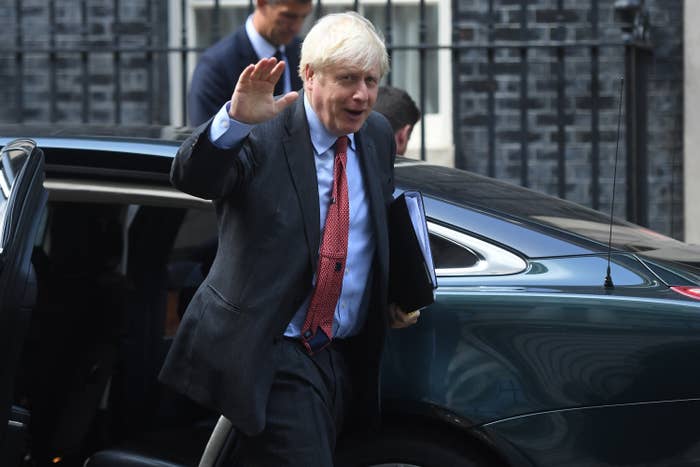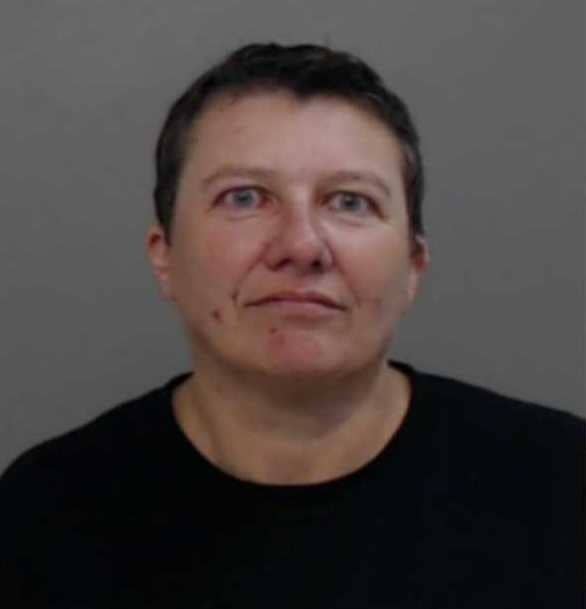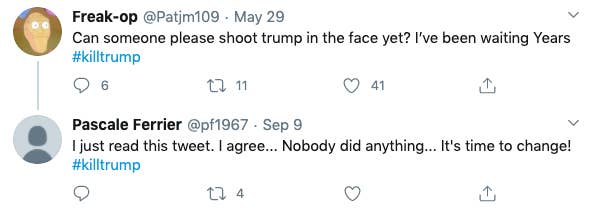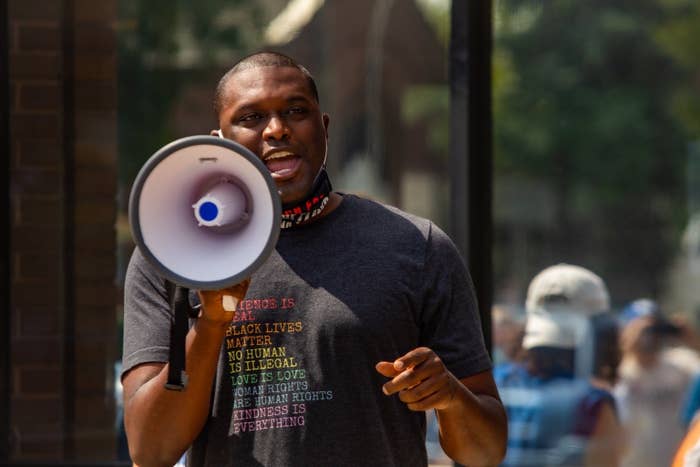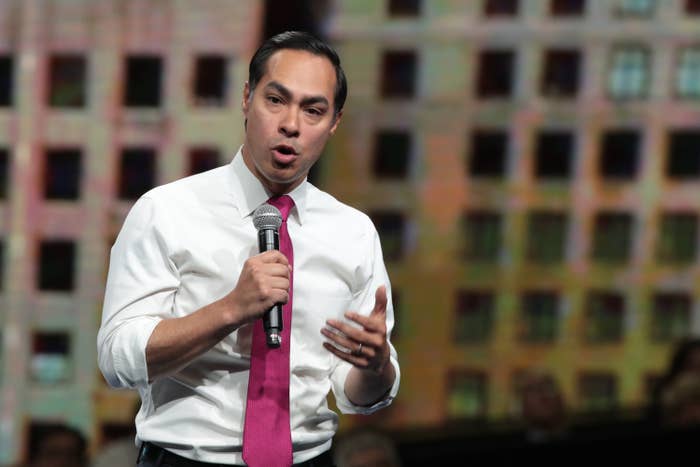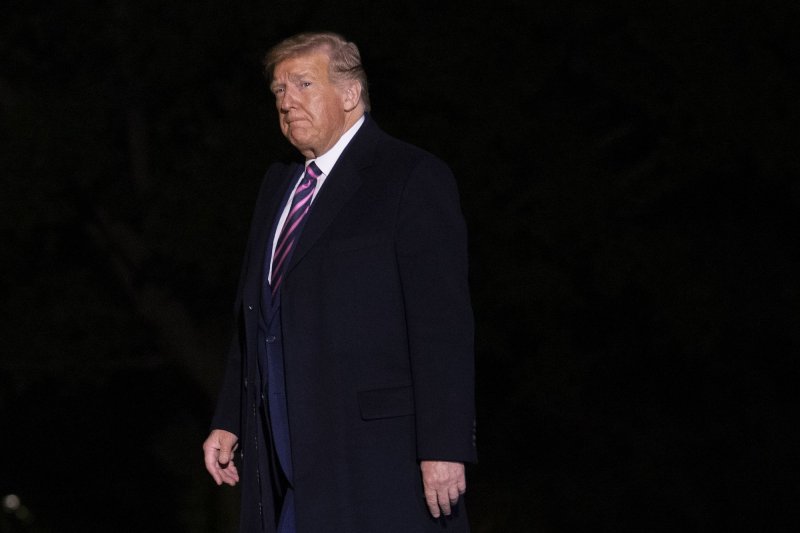We Aren’t Nationally Mourning The 200,000 COVID-19 Victims Because If We Did It Would Be A Reckoning
“If you actually recognize the horrific toll this is taking,” one history professor told BuzzFeed News, “then you’re acknowledging the weight of the problem and the failure of the response.”
“If you actually recognize the horrific toll this is taking,” one history professor told BuzzFeed News, “then you’re acknowledging the weight of the problem and the failure of the response.”
Amber Jamieson BuzzFeed News Reporter
Posted on September 22, 2020
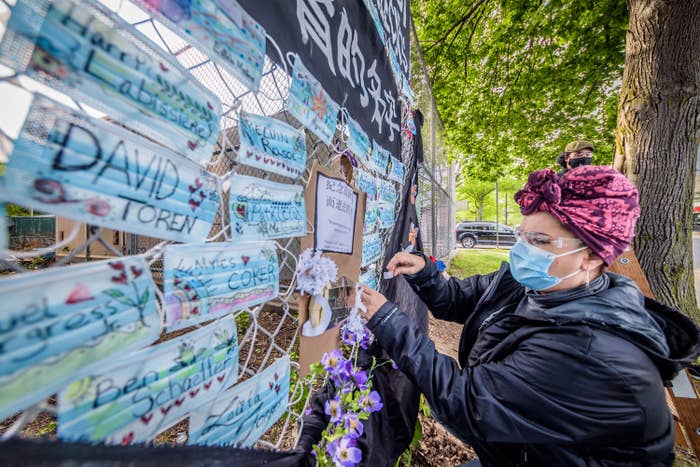
Erik McGregor/LightRocket via Getty Images
A volunteer artist setting up a memorial in the Bronx on May 19 to honor the victims of the pandemic.
Earlier this month, on Sept. 11, as has happened every year since the 2001 terror attacks, a moment of silence was held at 8:46 a.m. ET, the exact time a plane struck the north tower of the World Trade Center.
The names of the nearly 3,000 people killed were read aloud. Flags around the country were lowered to half-mast. Democratic nominee Joe Biden stopped his presidential campaign for the day. The Tribute in Light art installation projected two beams into the sky, exactly where the towers stood, as part of an annual ritual of grief.
And on that day, more than 1,100 Americans died from the coronavirus.
“The difference was on 9/11 we were attacked by a foreign agent,” said Martin Quinn, whose father, Frederick Harold Quinn, died in August from COVID-19 after two months of illness. “I almost feel like during the pandemic we’re attacked by our own country.”
Over six months into the coronavirus pandemic, 200,000 Americans have now died from the virus — a grim toll the country hit Tuesday. Despite the enormous number of deaths — and the impact felt deeply by survivors of the virus, loved ones of the dead, and those suffering the enormous economic fallout — there has been no official national mourning. No minute of silence, no plans for a memorial to be erected in their honor, no collective grieving.
Instead, at the highest levels of government, there have been attempts to downplay the severity of the pandemic and even discount the dead. On Wednesday, President Donald Trump insisted that the number of deaths from the coronavirus in the US — the highest in the world — was much lower “if you take the blue states out.” At a rally on Monday night, he told supporters, "it affects virtually nobody."
“There’s no acknowledgment of the death and the suffering, and that’s politically motivated,” said Quinn. “They want to brush the deaths under the rug. They want to ‘downplay’ it, in Donald Trump’s own words, and we’ve been robbed of mourning.”
Properly mourning and memorializing the dead would require a national reckoning with how government at every level mishandled the pandemic, how the US failed so much in contrast to other countries, and how structural inequalities made the virus much deadlier for Black and Latinx Americans.
But with the presidential election rapidly approaching and Trump seeking to shift focus from his administration’s response to the pandemic, politics is hindering any national effort to mourn for the coronavirus, according to Micki McElya, a history professor at the University of Connecticut and author of The Politics of Mourning: Death and Honor in Arlington National Cemetery. “If you actually recognize the horrific toll this is taking,” McElya told BuzzFeed News, “then you’re acknowledging the weight of the problem and the failure of the response.”
Courtesy of Diane Lent / Via Flickr: greenelent
Demonstrators with COVID Families marching on Sunday in New York City in honor of coronavirus victims.
In this vacuum of national mourning at a governmental level, activists who have had loved ones die because of the pandemic are filling the void. Quinn and other members of COVID Families, a group formed by the Center for Popular Democracy, organized a March for the Dead protest on Sunday, holding a moment of silence for Justice Ruth Bader Ginsburg and then marching to Trump Tower. On Monday night, a DC group called the COVID Memorial Project began placing 20,000 American flags on the National Mall in honor of the 200,000 people who have died. And on Oct. 4, the National COVID Remembrance, a protest day created by Covid Survivors for Change, a national community of families of COVID victims and survivors, will take place at the Ellipse in Washington, DC, calling for a national moment of silence.
Quinn co-organized the first March for the Dead, Fight for the Living protest in New York City on Aug. 21, just three days after his father’s death. The protest was a procession over the Brooklyn Bridge, with marchers dressed in white and carrying photos and even ashes of their loved ones killed by the virus, followed by a reading of victims’ names.
“[These activist protests] are building on a long tradition on activist mourning,” said history professor McElya, “using grief and anger and fury at the unnecessary loss of life that government neglect is producing.”
Both Quinn and McElya likened the demonstrations to activism during the HIV/AIDS epidemic. In 1991, activists put a condom over the home of then–North Carolina Republican senator Jesse Helms. In 1992, people scattered the ashes of their loved ones killed by the virus on the lawns outside the White House. The goal then, as it is now, was to try to force a governmental response that would lead to a national reckoning.

Benjamin Lowy / Getty Images
A woman walks past the New York City AIDS memorial in St Vincent's Park in Manhattan's West Village in 2017.
Over 100,000 New Yorkers had died from HIV/AIDS by the time the AIDS Memorial opened in Manhattan in 2016. The soaring sculpture and gathering place lies in the West Village on the former site of the city’s first and largest AIDS ward. “There was decades of lack of acknowledgment of how devastating the disease was to various communities, so part of the memorial is really about acknowledgment in a public way that bad things have happened,” memorial cofounder Christopher Tepper told BuzzFeed News.
The AIDS memorial is also a physical space, not just a monument, allowing people to come together. After the death of AIDs activist Larry Kramer in May, people gathered there to grieve. The memorial has also been the site of protests, poetry readings, and candlelight vigils.
Posted on September 22, 2020

Erik McGregor/LightRocket via Getty Images
A volunteer artist setting up a memorial in the Bronx on May 19 to honor the victims of the pandemic.
Earlier this month, on Sept. 11, as has happened every year since the 2001 terror attacks, a moment of silence was held at 8:46 a.m. ET, the exact time a plane struck the north tower of the World Trade Center.
The names of the nearly 3,000 people killed were read aloud. Flags around the country were lowered to half-mast. Democratic nominee Joe Biden stopped his presidential campaign for the day. The Tribute in Light art installation projected two beams into the sky, exactly where the towers stood, as part of an annual ritual of grief.
And on that day, more than 1,100 Americans died from the coronavirus.
“The difference was on 9/11 we were attacked by a foreign agent,” said Martin Quinn, whose father, Frederick Harold Quinn, died in August from COVID-19 after two months of illness. “I almost feel like during the pandemic we’re attacked by our own country.”
Over six months into the coronavirus pandemic, 200,000 Americans have now died from the virus — a grim toll the country hit Tuesday. Despite the enormous number of deaths — and the impact felt deeply by survivors of the virus, loved ones of the dead, and those suffering the enormous economic fallout — there has been no official national mourning. No minute of silence, no plans for a memorial to be erected in their honor, no collective grieving.
Instead, at the highest levels of government, there have been attempts to downplay the severity of the pandemic and even discount the dead. On Wednesday, President Donald Trump insisted that the number of deaths from the coronavirus in the US — the highest in the world — was much lower “if you take the blue states out.” At a rally on Monday night, he told supporters, "it affects virtually nobody."
“There’s no acknowledgment of the death and the suffering, and that’s politically motivated,” said Quinn. “They want to brush the deaths under the rug. They want to ‘downplay’ it, in Donald Trump’s own words, and we’ve been robbed of mourning.”
Properly mourning and memorializing the dead would require a national reckoning with how government at every level mishandled the pandemic, how the US failed so much in contrast to other countries, and how structural inequalities made the virus much deadlier for Black and Latinx Americans.
But with the presidential election rapidly approaching and Trump seeking to shift focus from his administration’s response to the pandemic, politics is hindering any national effort to mourn for the coronavirus, according to Micki McElya, a history professor at the University of Connecticut and author of The Politics of Mourning: Death and Honor in Arlington National Cemetery. “If you actually recognize the horrific toll this is taking,” McElya told BuzzFeed News, “then you’re acknowledging the weight of the problem and the failure of the response.”
Courtesy of Diane Lent / Via Flickr: greenelent
Demonstrators with COVID Families marching on Sunday in New York City in honor of coronavirus victims.
In this vacuum of national mourning at a governmental level, activists who have had loved ones die because of the pandemic are filling the void. Quinn and other members of COVID Families, a group formed by the Center for Popular Democracy, organized a March for the Dead protest on Sunday, holding a moment of silence for Justice Ruth Bader Ginsburg and then marching to Trump Tower. On Monday night, a DC group called the COVID Memorial Project began placing 20,000 American flags on the National Mall in honor of the 200,000 people who have died. And on Oct. 4, the National COVID Remembrance, a protest day created by Covid Survivors for Change, a national community of families of COVID victims and survivors, will take place at the Ellipse in Washington, DC, calling for a national moment of silence.
Quinn co-organized the first March for the Dead, Fight for the Living protest in New York City on Aug. 21, just three days after his father’s death. The protest was a procession over the Brooklyn Bridge, with marchers dressed in white and carrying photos and even ashes of their loved ones killed by the virus, followed by a reading of victims’ names.
“[These activist protests] are building on a long tradition on activist mourning,” said history professor McElya, “using grief and anger and fury at the unnecessary loss of life that government neglect is producing.”
Both Quinn and McElya likened the demonstrations to activism during the HIV/AIDS epidemic. In 1991, activists put a condom over the home of then–North Carolina Republican senator Jesse Helms. In 1992, people scattered the ashes of their loved ones killed by the virus on the lawns outside the White House. The goal then, as it is now, was to try to force a governmental response that would lead to a national reckoning.

Benjamin Lowy / Getty Images
A woman walks past the New York City AIDS memorial in St Vincent's Park in Manhattan's West Village in 2017.
Over 100,000 New Yorkers had died from HIV/AIDS by the time the AIDS Memorial opened in Manhattan in 2016. The soaring sculpture and gathering place lies in the West Village on the former site of the city’s first and largest AIDS ward. “There was decades of lack of acknowledgment of how devastating the disease was to various communities, so part of the memorial is really about acknowledgment in a public way that bad things have happened,” memorial cofounder Christopher Tepper told BuzzFeed News.
The AIDS memorial is also a physical space, not just a monument, allowing people to come together. After the death of AIDs activist Larry Kramer in May, people gathered there to grieve. The memorial has also been the site of protests, poetry readings, and candlelight vigils.
But, Tepper said, politics also colored people’s perceptions of the monument. “When it was being built, people asked, ‘Why would you build a memorial to a disease? Why wouldn’t you build a memorial to cancer survivors if you’re going to build one to AIDS?’” recalled Tepper. “That comes from a place from sheltered misunderstanding to how impactful the AIDS crisis was to specific communities.”
In contrast, the sudden shock and horror of 9/11 became a traumatic bonding experience for the whole country, a collective experience witnessed by people everywhere on their television screens. Flower memorials sprung up around the country, not just in the spaces where the attacks occurred. US embassies around the world were swamped with people leaving notes of condolence and lighting candles. Grief was everywhere and the loss was acknowledged. “We felt like our sadness was recognized by the government,” said Quinn, who lived in New York City at the time of the attack. “It’s the opposite feeling now.”

John Minchillo / AP
Mourners place flowers and pictures at the National September 11 Memorial and Museum on Sept. 11, 2020.
Back in May, McElya wrote a column for the Washington Post entitled “Almost 90,000 Dead and No Hint of National Mourning. Are These Deaths Not ‘Ours’?,” comparing how the US treats those killed in war or terror attacks to deaths from the coronavirus or the HIV/AIDS epidemic.
“The protests and the political funerals and organic swell of refusal not to mourn by the American people is exactly what I was looking for in May,” McElya told BuzzFeed News. “It’s about challenging the state and challenging the country to wake up, [about asking] why it values some people less than others, why it refuses to mark some deaths and honors others.”
She sees the new wave of COVID-19 memorial protests as a direct outcome of the summer’s Black Lives Matter demonstrations. Both require Americans to confront and grapple with questions of why Black people are more likely to die than white people at the hands of police and as a result of the virus. “It’s a failure to value Black lives or honor Black deaths. I think they are intimately, directly connected,” said McElya.
Latinx Americans are also deeply suffering from the virus, being four times more likely to be hospitalized with COVID-19 than white people. But they too are demanding their dead not be forgotten. Maria del Rosario Palacios, 30, will be traveling from her home in Gainesville, Georgia, to attend the National COVID Remembrance on Oct. 4 in DC, where a moment of silence will be held to highlight the plight of essential workers and the Latinx community. “This is us coming together to honor what has happened and the folks we’ve lost,” said Palacios.
The single mother-of-three survived COVID-19 and said the virus has completely disrupted her life. A grandparent of hers died, and two of her children suffered symptoms of the disease. For months her mother was also sick, experiencing a stroke and developing diabetes, unable to return to her job as an essential worker at a poultry plant since June. As a COVID-19 long-hauler, her mother now requires twice-weekly doctor visits.
Palacios said she’s felt deeply isolated throughout the pandemic and the lack of mourning has felt like a lack of community. “It doesn’t feel like…we’ve been able to come together as a country,” she said, “especially with the disproportionate amount of death we’ve had.”

Aaron J. Thornton / Getty Images
Relatives of COVID-19 victims drive next to their images displayed in a drive-by memorial at Belle Isle State Park on Sept. 2 in Detroit.
Detroit is one of the few cities to host official events, turning Memorial Day festivities on Aug. 31 into a remembrance of citizens who died from the virus. Residents rang bells for 15 minutes to honor the 1,500 dead and families of victims partook in a drive-thru procession in Belle Isle Park.
But even where deaths from the virus have been highest, there has been little discussion of how to mourn the victims. Over 23,000 people have died from COVID-19 in New York City and while Mayor Bill de Blasio announced in May a plan for a ticker-tape parade to honor healthcare workers once the pandemic is over, there has been no discussion from his office of anything more somber for the dead. Mayoral spokesperson Mitch Schwartz confirmed to BuzzFeed News the city still hopes to hold the healthcare worker parade “when large gatherings are safe...But right now, the best way to thank those workers and honor those we’ve lost is to fight COVID-19 in our own lives. Wear a mask, practice social distancing, and check in on your neighbors.”
In New York City, smaller memorials are instead springing up. March for the Dead wants to create ad hoc shrines around the city, said Quinn, similar to those that emerged after 9/11 in Union Square and in subway stations, with photos and flowers of those who were killed. For several weeks in August and early September, the Brooklyn Botanic Garden played a sound installation composed to honor COVID victims in its famous cherry tree esplanade, which this year bloomed to no visitors. Artist Kristina Libby has also been creating floral hearts and placing them in iconic New York locations as a tribute to those who died from the virus. “These are my small steps towards creating a memorial, to having a larger cultural conversation about dying and to knitting us closer together as a community,” she wrote Friday in an Instagram caption.

View this photo on Instagram
Instagram: @kristinamlibby
Memorials, whether permanent or temporary, would give people a space to grieve. Many like Quinn who’ve had loved ones die from the virus couldn’t hold large funerals due to the pandemic. Now, they fear these victims will be forgotten. “I feel robbed of mourning,” said Quinn.
A sympathy card from a family friend last week described his father, an 87-year-old former activist priest in New Jersey who sung sentences to his son to the tune of “Baby Shark,” as a “cheerleader of everyone around him.” For six months before his death, he’d been unable to see his family because of the quarantine restrictions. Quinn feels bereft, but not without hope. “I'm trying to channel all my anger and sadness into action,” he said.
The COVID Families group modeled itself on the September 11th Families’ Association, a nonprofit that represents victims and built the 9/11 Tribute Museum. The new organization serves as a community of survivors, said Jennifer Lynn Walker, senior director of mobilization and advocacy for the Center for Popular Democracy, which is leading the COVID Families project. But it is also, she said, a fundamentally political group designed to “come together and get restitution, and serve as a moral voice for future policies, so there’s not the same level of government failure.”
For the COVID-19 victims’ families, mourning is not just about grief, or moving on, but about figuring out how we got here and making sure it doesn’t happen again.
“Moments of national mourning are both collectively healing, but they can also be a time of reckoning,” said McElya, the history professor. “Reckoning is what this country seems utterly resistant to doing.”

Amber Jamieson is a reporter for BuzzFeed News and is based in New York.
In contrast, the sudden shock and horror of 9/11 became a traumatic bonding experience for the whole country, a collective experience witnessed by people everywhere on their television screens. Flower memorials sprung up around the country, not just in the spaces where the attacks occurred. US embassies around the world were swamped with people leaving notes of condolence and lighting candles. Grief was everywhere and the loss was acknowledged. “We felt like our sadness was recognized by the government,” said Quinn, who lived in New York City at the time of the attack. “It’s the opposite feeling now.”

John Minchillo / AP
Mourners place flowers and pictures at the National September 11 Memorial and Museum on Sept. 11, 2020.
Back in May, McElya wrote a column for the Washington Post entitled “Almost 90,000 Dead and No Hint of National Mourning. Are These Deaths Not ‘Ours’?,” comparing how the US treats those killed in war or terror attacks to deaths from the coronavirus or the HIV/AIDS epidemic.
“The protests and the political funerals and organic swell of refusal not to mourn by the American people is exactly what I was looking for in May,” McElya told BuzzFeed News. “It’s about challenging the state and challenging the country to wake up, [about asking] why it values some people less than others, why it refuses to mark some deaths and honors others.”
She sees the new wave of COVID-19 memorial protests as a direct outcome of the summer’s Black Lives Matter demonstrations. Both require Americans to confront and grapple with questions of why Black people are more likely to die than white people at the hands of police and as a result of the virus. “It’s a failure to value Black lives or honor Black deaths. I think they are intimately, directly connected,” said McElya.
Latinx Americans are also deeply suffering from the virus, being four times more likely to be hospitalized with COVID-19 than white people. But they too are demanding their dead not be forgotten. Maria del Rosario Palacios, 30, will be traveling from her home in Gainesville, Georgia, to attend the National COVID Remembrance on Oct. 4 in DC, where a moment of silence will be held to highlight the plight of essential workers and the Latinx community. “This is us coming together to honor what has happened and the folks we’ve lost,” said Palacios.
The single mother-of-three survived COVID-19 and said the virus has completely disrupted her life. A grandparent of hers died, and two of her children suffered symptoms of the disease. For months her mother was also sick, experiencing a stroke and developing diabetes, unable to return to her job as an essential worker at a poultry plant since June. As a COVID-19 long-hauler, her mother now requires twice-weekly doctor visits.
Palacios said she’s felt deeply isolated throughout the pandemic and the lack of mourning has felt like a lack of community. “It doesn’t feel like…we’ve been able to come together as a country,” she said, “especially with the disproportionate amount of death we’ve had.”

Aaron J. Thornton / Getty Images
Relatives of COVID-19 victims drive next to their images displayed in a drive-by memorial at Belle Isle State Park on Sept. 2 in Detroit.
Detroit is one of the few cities to host official events, turning Memorial Day festivities on Aug. 31 into a remembrance of citizens who died from the virus. Residents rang bells for 15 minutes to honor the 1,500 dead and families of victims partook in a drive-thru procession in Belle Isle Park.
But even where deaths from the virus have been highest, there has been little discussion of how to mourn the victims. Over 23,000 people have died from COVID-19 in New York City and while Mayor Bill de Blasio announced in May a plan for a ticker-tape parade to honor healthcare workers once the pandemic is over, there has been no discussion from his office of anything more somber for the dead. Mayoral spokesperson Mitch Schwartz confirmed to BuzzFeed News the city still hopes to hold the healthcare worker parade “when large gatherings are safe...But right now, the best way to thank those workers and honor those we’ve lost is to fight COVID-19 in our own lives. Wear a mask, practice social distancing, and check in on your neighbors.”
In New York City, smaller memorials are instead springing up. March for the Dead wants to create ad hoc shrines around the city, said Quinn, similar to those that emerged after 9/11 in Union Square and in subway stations, with photos and flowers of those who were killed. For several weeks in August and early September, the Brooklyn Botanic Garden played a sound installation composed to honor COVID victims in its famous cherry tree esplanade, which this year bloomed to no visitors. Artist Kristina Libby has also been creating floral hearts and placing them in iconic New York locations as a tribute to those who died from the virus. “These are my small steps towards creating a memorial, to having a larger cultural conversation about dying and to knitting us closer together as a community,” she wrote Friday in an Instagram caption.

View this photo on Instagram
Instagram: @kristinamlibby
Memorials, whether permanent or temporary, would give people a space to grieve. Many like Quinn who’ve had loved ones die from the virus couldn’t hold large funerals due to the pandemic. Now, they fear these victims will be forgotten. “I feel robbed of mourning,” said Quinn.
A sympathy card from a family friend last week described his father, an 87-year-old former activist priest in New Jersey who sung sentences to his son to the tune of “Baby Shark,” as a “cheerleader of everyone around him.” For six months before his death, he’d been unable to see his family because of the quarantine restrictions. Quinn feels bereft, but not without hope. “I'm trying to channel all my anger and sadness into action,” he said.
The COVID Families group modeled itself on the September 11th Families’ Association, a nonprofit that represents victims and built the 9/11 Tribute Museum. The new organization serves as a community of survivors, said Jennifer Lynn Walker, senior director of mobilization and advocacy for the Center for Popular Democracy, which is leading the COVID Families project. But it is also, she said, a fundamentally political group designed to “come together and get restitution, and serve as a moral voice for future policies, so there’s not the same level of government failure.”
For the COVID-19 victims’ families, mourning is not just about grief, or moving on, but about figuring out how we got here and making sure it doesn’t happen again.
“Moments of national mourning are both collectively healing, but they can also be a time of reckoning,” said McElya, the history professor. “Reckoning is what this country seems utterly resistant to doing.”

Amber Jamieson is a reporter for BuzzFeed News and is based in New York.



